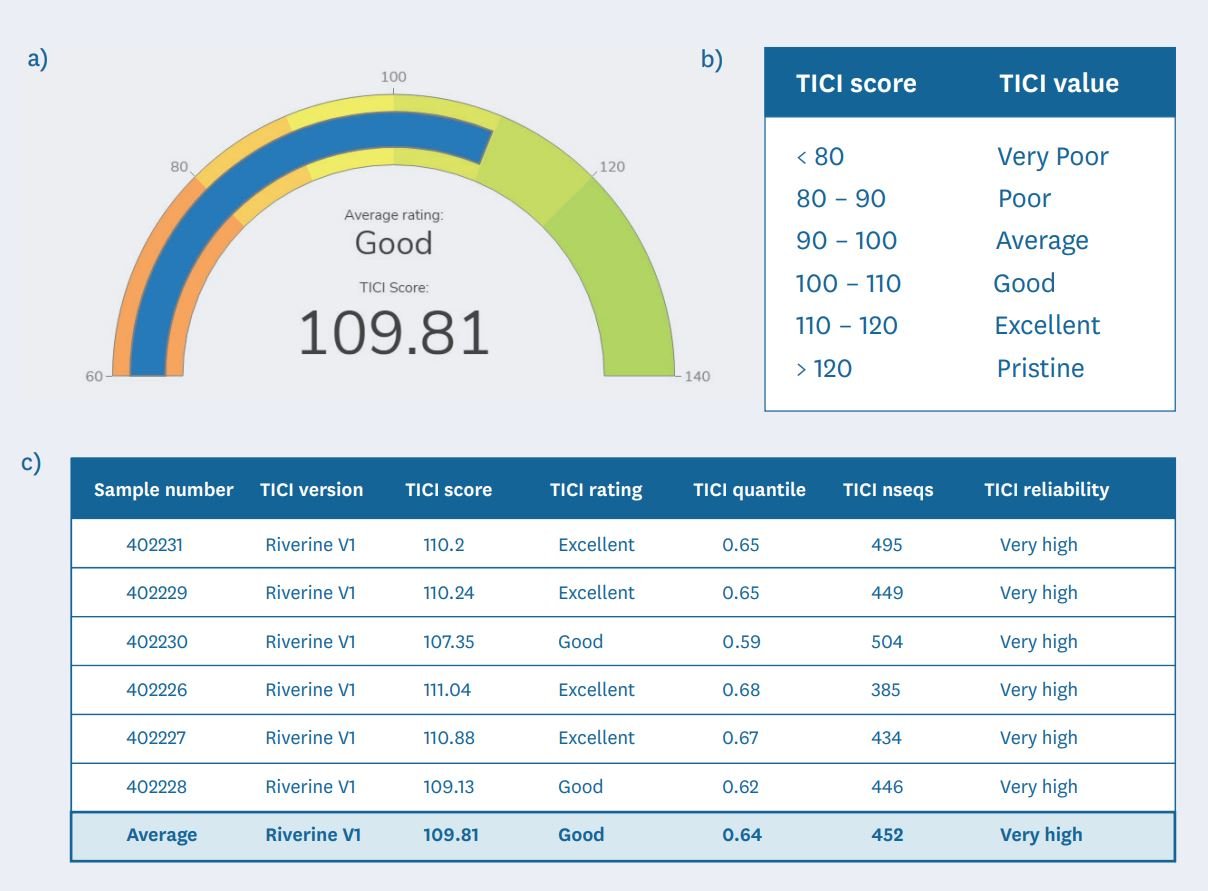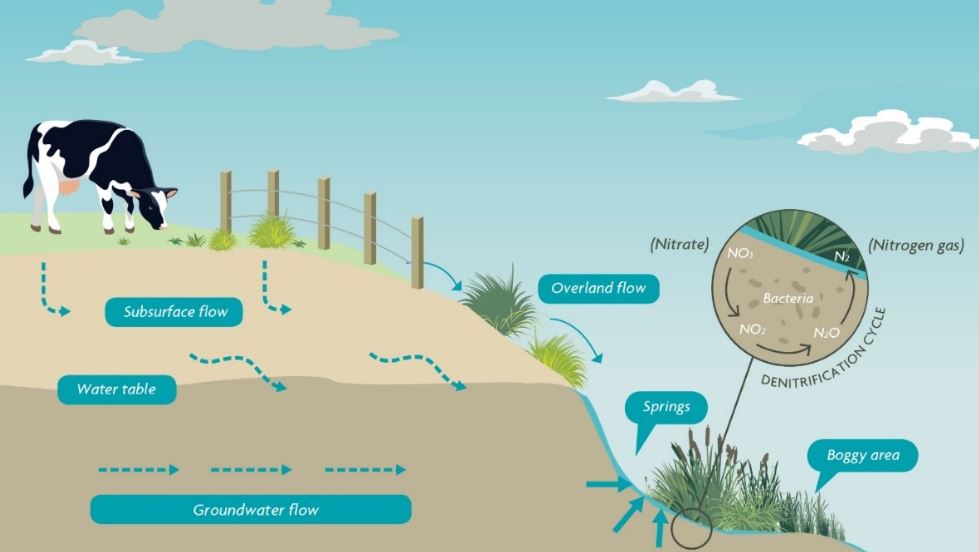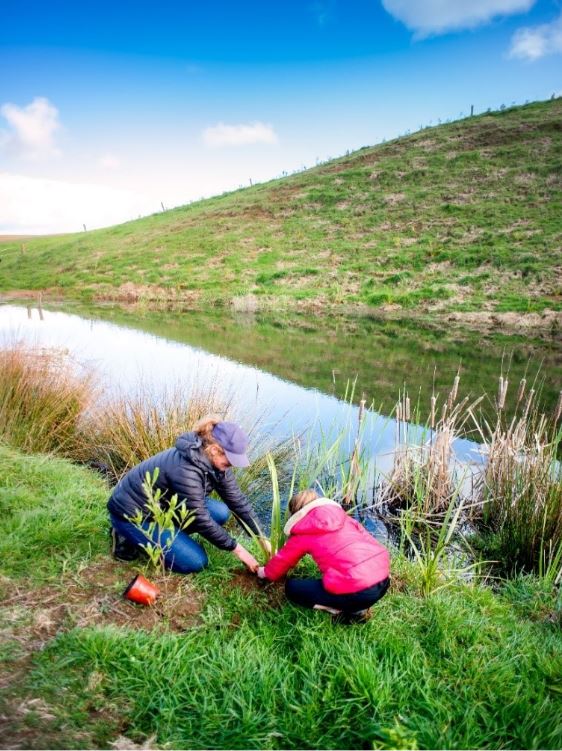Catchment groups offer a great opportunity for you and your local community to enhance and improve the biodiversity, water quality, and amenity value of your catchment and downstream environs. DairyNZ is here to empower you and your group to achieve your goals and aspirations.
There are a number of great resources to assist you and your group at whatever stage your catchment group is at. If you’re just getting started or part of a well-established group, check out the helpful resources in the sections below.
The importance of catchment groups
Catchment groups are New Zealand’s best opportunity in a generation to make progress on improving our waterways, and native biodiversity on farm.
Formed for a variety of reasons, these groups offer a platform for sharing knowledge, adopting good management practices, addressing challenges related to water management and ultimately helping communities enhance their local environments.
Why get involved
Catchment groups have been established up and down the country with increasing support from industry and Government. This is because it has been recognised that local community involvement is one of the keys to the long-term health and enhancement of waterways and biodiversity in a catchment.
Being involved in a catchment group can yield substantial benefits in terms of positive environmental and community outcomes. With a wide variety of support available, there has never been a better time to get involved.
Getting started
Have you thought about forming a catchment group but are not sure where to start? Check out:
- How-to-Start-a-Catchment-Group.pdf (beeflambnz.com)
- A guide to catchment restoration: Waituna Creek restoration trial (cawthron.org.nz)
You’ll find a step-by-step guide to getting your community and local iwi together to build a shared vision and action plan for your catchment.
Creating the goals and structure of your group
Once you have a group established, you’ll need to define your vision and goals, and decide on a group structure. It’s important that your group’s structure works for your members. Structures range from informal to formal. Formal groups will have assigned roles such as a chairperson, secretary, treasurer etc. You may also choose to become an incorporated society or charitable trust.
What’s best for your group? Read the following resources by the NZ Landcare Trust:
Applying for funding
Most catchment groups will require funding to achieve your goals. As a group – you'll need to sell yourselves and your project to potential funders.
To get started, read the Guide to successful grant applications by Exult – one of New Zealand’s leading community training providers.
DairyNZ and Landcare trust have co-developed resources to find out what funding is available nationally and regionally. Head to Lancare Trust: NZ Landcare Trusts Funding Resources by Region, and see their Tips and Tricks for Funding Applications.
Understanding your catchment's current situation
What’s the environmental ‘health’ like in your catchment? How do you find out and what information do you need?
Understanding your catchment and where it sits environmentally is an important part of the process of deciding what you would like to achieve as a group. Baseline data and information for your catchment give you a good foundation from which to measure improvements and understand where the major issues are in your catchment.
To get a broad understanding of the environmental health near you, search Land Air Water Aotearoa (LAWA) for local information on river, lake and groundwater water quality, recreational water quality, water quantity, land cover and estuary health.
Waterways - water quality and biodiversity
There are many variables to consider when looking at water quality. These include physical and chemical characteristics. See NZ Landcare Trust’s Water Quality Terms for descriptions of variables such as clarity; conductivity; dissolved oxygen; habitat, nitrogen – and more.
Conducting an eDNA test can be a great way to understand what biodiversity you have in your catchment's waterways and get an understanding of overall waterway health. An eDNA assessment will also provide you with a taxon-independent community index (TICI) score, which will give your waterway a score from very poor to pristine.
To get started with eDNA to collect your baseline data, see:
- What is environmental DNA (Environmental Protection Authority)
- Tips for eDNA sampling and analysis – and how to interpret results (Wilderlab)

Practical steps you can take as a group
Improving the overall health of your catchment involves reducing the impacts of contaminants. This means both contaminant reduction at the source and implementing proactive mitigation solutions such as riparian planting.
The following resources give useful tips for reducing contaminants and their impacts:

Positive actions on-farm
There are a number of positive actions you can take as a group to improve the catchment. For example:
- Fencing waterways and critical source areas
- Riparian strip planting of waterways
- Buffer planting
- Fish ladders
- Wetland management

See the following to find out more:
- On-farm actions: Waterways
- Riparian buffer design guide: Design to meet water quality objectives (NIWA)
- Riparian buffer video guide: The right buffer for your farm (NIWA)
- Wetlands: What are they and why are they so important? (NZ Landcare Trust)
- How to plant: Planting waterways (DairyNZ)
- Pest control: Trap in your community (Predator Free 2050)
- Farming with native biodiversity: resources collection (NZ Landcare Trust)
- NZ Landcare Trust - Native fish guide
- Native biodiversity farming guide
- Planting under central pivot irrigation
Keeping up group momentum
Initial success and progress are important however, for long-term success and improvement, you need to ensure your group has longevity. There are many aspects to ensuring long-term success, supporting your coordinators, and ensuring that you have a range of people with different skill sets involved, alongside achievable goals and good links to funding sources.
For additional technical support for your group, a good option is to register with the A2E who provide technical support for all aspect of catchment group management.
- How it works: Access to Experts (access2experts.net.nz)
Read the following to find out more:
- Community Catchment Management: A community-owned catchment approach (NZ Landcare Trust)
- The Catchment Group Toolkit: Our Land and Water website
Regional information
Northland - Te Tai Tokerau
- Catchment management plans (Northland Regional Council)
- Planting advice (Northland Regional Council)
- Group directory (Department of Conservation)
- Funding for landowners (Northland Regional Council)
- Land management advice (DairyNZ)
- Waimā Waitai Waiora project (Northland Regional Council)
The project is a collective of Northland organisations, stakeholders and mana whenua working together to assist landowners to implement sustainable land management practices on their lands in and around the Northern Kaipara catchment.
Auckland- Tāmaki-makau-rau
- Caring for waterways guide (Auckland Council)
- Streamside planting guide (Auckland Council)
- Group directory (Environmental Protection Authority)
Waikato
- Catchment managment zones (Waikato Regional Council)
- Group Directory (Waikato Regional Council)
- Planting guide (Waikato Regional Council)
- Wetland planting guide (Waikato Regional Council)
- Funding options (NZ Landcare Trust)
Bay of Plenty- Te Moana-a-Toi
- Group directory and overall objectives (Bay of Plenty Regional Council)
- Catchment action plans and assessment reports (Bay of Plenty Regional Council)
- Planting guide (Bay of Plenty Regional Council)
- Funding options (NZ Landcare Trust)
Gisborne- Te Tairāwhiti
- Catchment plans (Gisborne District Council)
- Wetlands guidance (Gisborne District Council)
- State of our environment report (Gisborne District Council)
- Group directory (Beef+Lamb NZ)
Hawke’s Bay- Te Matau-a-Māui
- Catchment plans (Hawke's Bay Regional Council)
- Group directory (Beef+Lamb NZ)
- Planting planning assistance (Hawke's Bay Regional Council)
- Planting guide (Hawke's Bay Regional Council)
- Freshwater monitoring in the region (Land, Air, Water, Aotearoa)
Taranaki
- Group directory (Taranaki Catchment Communities)
- Sustainable land use report (Taranaki Catchment Communities)
- Riparian managment (Taranaki Regional Council)
- Riparian planting on-farm (DairyNZ)
Manawatū-Whanganui
- Collaboration Projects (Horizons Regional Council)
- State of environment summary infographic (Horizons Regional Council)
- Catchment data (Land, Air, Water, Aotearoa)
- Riparian management guide (DairyNZ)
- Funding options (NZ Landcare Trust)
Wellington- Te Whanga-nui-a-Tara- Waiarapa
- Riparian planting guide (DairyNZ)
- Catchment group directory (Beef+Lamb NZ)
- Whaitua: catchment managment through the GWRC (Greater Wellington Regional Council)
Tasman- Te Tai-o-Aorere
- Riparian planting guide (DairyNZ)
- Catchment group directory, funding and support (Tasman District Council)
Marlborough- Te Tauihu-o-te-waka
- Riparian management guide (DairyNZ)
- Funding options (NZ Landcare Trust)
- District council support (Marlborough District Council)
West Coast- Te Tai Poutini
- Riparian managment guide (DairyNZ)
- Funding options (NZ Landcare Trust)
Canterbury - Waitaha
- Riparian management guide (DairyNZ)
- Land management (DairyNZ)
- Planting guide (Environment Canterbury Regional Council)
- Group directory (NZ Landcare Trust)
Otago - Ōtākou
- Funding options (NZ Landcare Trust)
- Clutha catchment group (Clutha NZ)
- Catchment group program (Otago Catchment Community)
- Riparian managment guide (DairyNZ)
- Land management (DairyNZ)
- Native planting guide (Otago Regional Council)
Southland - Murihiku
- Riparian mangement guide (DairyNZ)
- Thriving Southland
Groups doing great things
- Taiea te Taiao, Ecological Corridor (arcgis.com)
- The-Rai-Valley-Project-Book.pdf (NZ Landcare Trust)